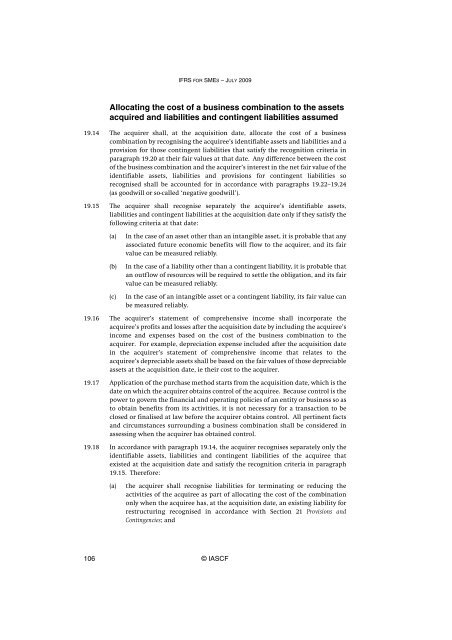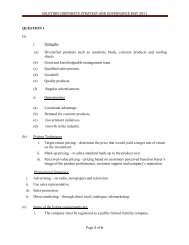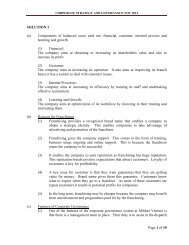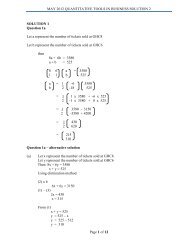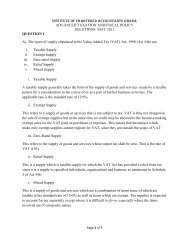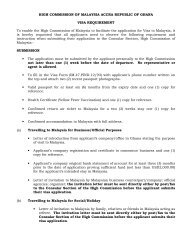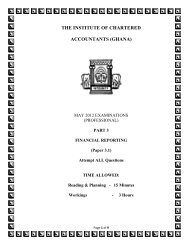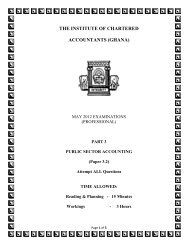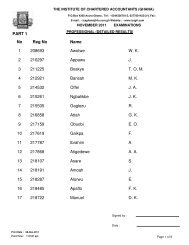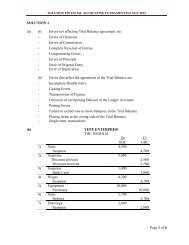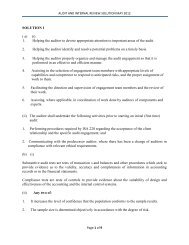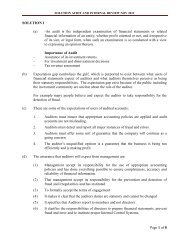(IFRS) for Small and Medium-sized Entities (SMEs)
(IFRS) for Small and Medium-sized Entities (SMEs)
(IFRS) for Small and Medium-sized Entities (SMEs)
Create successful ePaper yourself
Turn your PDF publications into a flip-book with our unique Google optimized e-Paper software.
<strong>IFRS</strong> FOR SMES – JULY 2009Allocating the cost of a business combination to the assetsacquired <strong>and</strong> liabilities <strong>and</strong> contingent liabilities assumed19.14 The acquirer shall, at the acquisition date, allocate the cost of a businesscombination by recognising the acquiree’s identifiable assets <strong>and</strong> liabilities <strong>and</strong> aprovision <strong>for</strong> those contingent liabilities that satisfy the recognition criteria inparagraph 19.20 at their fair values at that date. Any difference between the costof the business combination <strong>and</strong> the acquirer’s interest in the net fair value of theidentifiable assets, liabilities <strong>and</strong> provisions <strong>for</strong> contingent liabilities sorecognised shall be accounted <strong>for</strong> in accordance with paragraphs 19.22–19.24(as goodwill or so-called ‘negative goodwill’).19.15 The acquirer shall recognise separately the acquiree’s identifiable assets,liabilities <strong>and</strong> contingent liabilities at the acquisition date only if they satisfy thefollowing criteria at that date:(a)(b)(c)In the case of an asset other than an intangible asset, it is probable that anyassociated future economic benefits will flow to the acquirer, <strong>and</strong> its fairvalue can be measured reliably.In the case of a liability other than a contingent liability, it is probable thatan outflow of resources will be required to settle the obligation, <strong>and</strong> its fairvalue can be measured reliably.In the case of an intangible asset or a contingent liability, its fair value canbe measured reliably.19.16 The acquirer’s statement of comprehensive income shall incorporate theacquiree’s profits <strong>and</strong> losses after the acquisition date by including the acquiree’sincome <strong>and</strong> expenses based on the cost of the business combination to theacquirer. For example, depreciation expense included after the acquisition datein the acquirer’s statement of comprehensive income that relates to theacquiree’s depreciable assets shall be based on the fair values of those depreciableassets at the acquisition date, ie their cost to the acquirer.19.17 Application of the purchase method starts from the acquisition date, which is thedate on which the acquirer obtains control of the acquiree. Because control is thepower to govern the financial <strong>and</strong> operating policies of an entity or business so asto obtain benefits from its activities, it is not necessary <strong>for</strong> a transaction to beclosed or finalised at law be<strong>for</strong>e the acquirer obtains control. All pertinent facts<strong>and</strong> circumstances surrounding a business combination shall be considered inassessing when the acquirer has obtained control.19.18 In accordance with paragraph 19.14, the acquirer recognises separately only theidentifiable assets, liabilities <strong>and</strong> contingent liabilities of the acquiree thatexisted at the acquisition date <strong>and</strong> satisfy the recognition criteria in paragraph19.15. There<strong>for</strong>e:(a)the acquirer shall recognise liabilities <strong>for</strong> terminating or reducing theactivities of the acquiree as part of allocating the cost of the combinationonly when the acquiree has, at the acquisition date, an existing liability <strong>for</strong>restructuring recognised in accordance with Section 21 Provisions <strong>and</strong>Contingencies; <strong>and</strong>106 © IASCF


